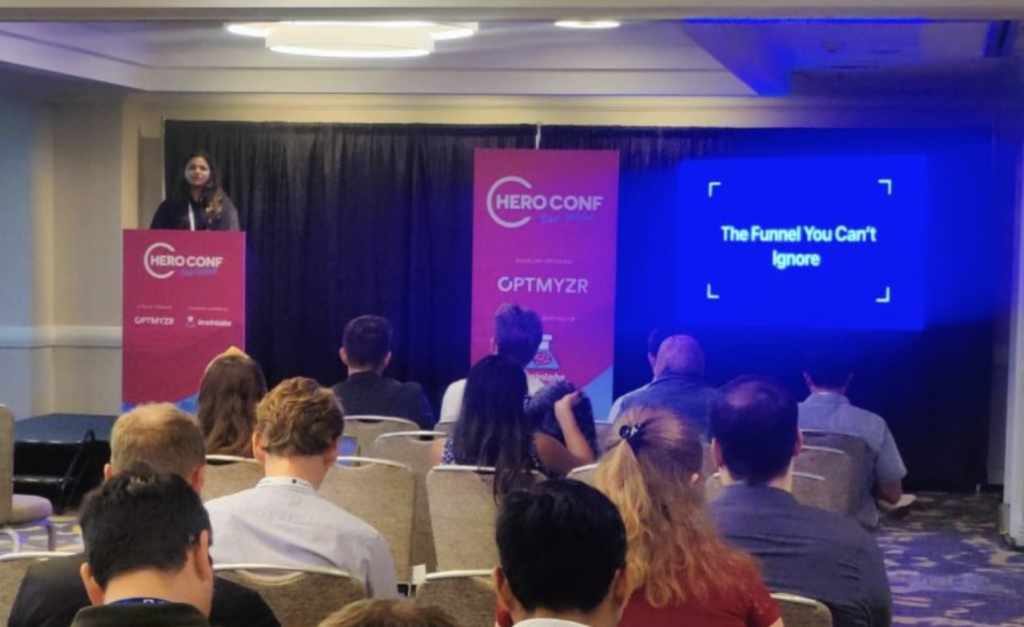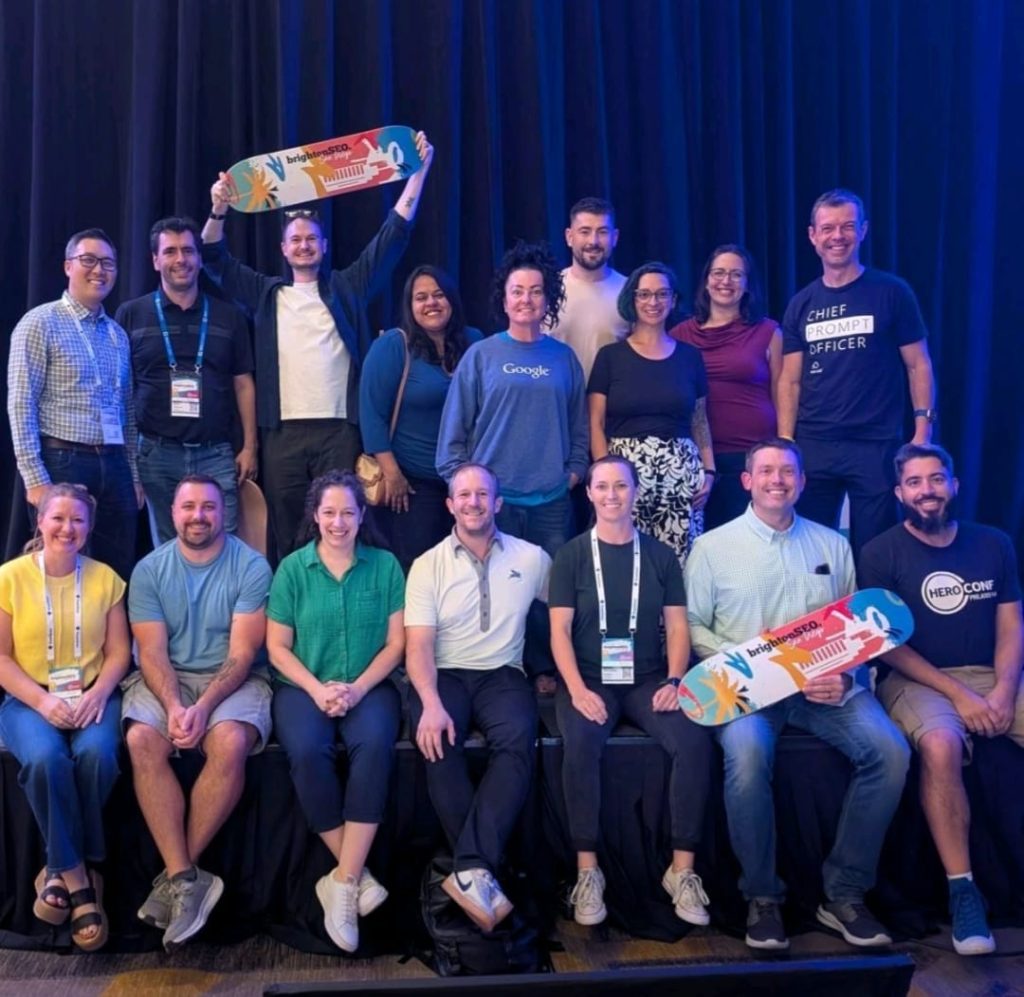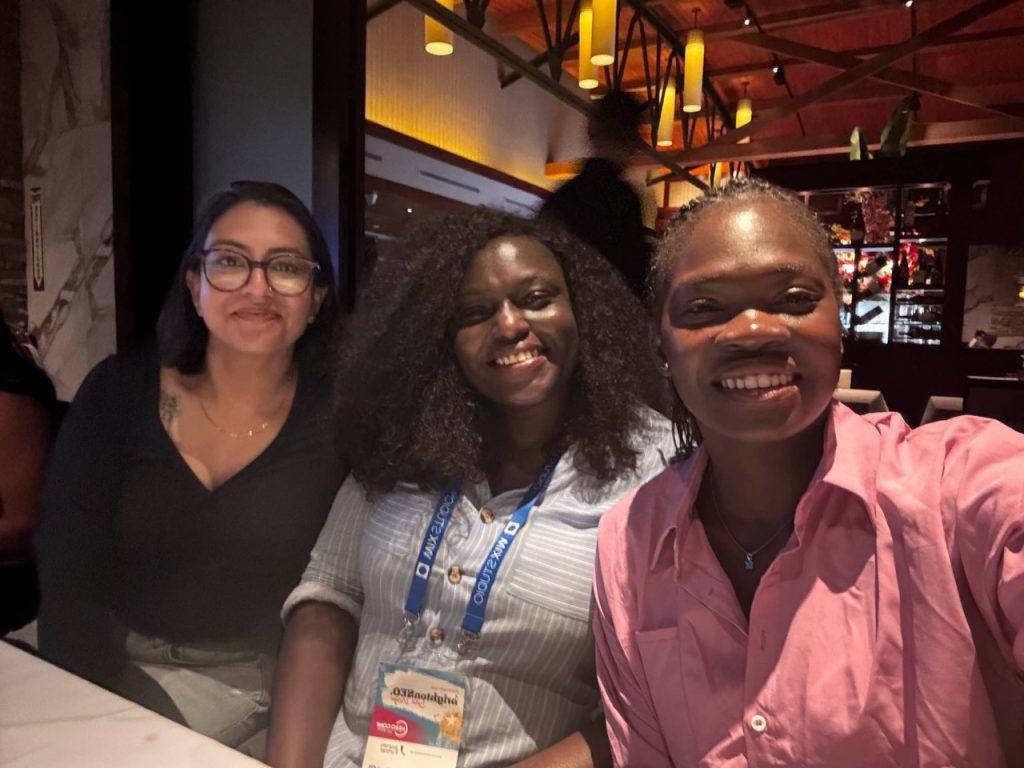I was at HeroConf (run by brightonSEO) in San Diego last month and it was fantastic. It was amazing to hang out with the PPC community that was out there in the US. They have such a great energy and a desire to gather and really dig into the changes Google, Microsoft, etc are making. What is working, what isn’t working, warding off the mistakes people are making and more.

The PPC community are a close knit group and we had a great time together – especially in our two rooms. Over the two days – there were close to 40 talks and there was so much to absorb. Below I give a summary of my favourites:

AI and the Future of Advertising:
- “Navigating the AI Revolution: Crafting Website Copy That Stands Out in the Age of Generative AI” by Greg McCoy discusses how generative AI has shifted the search landscape, requiring websites to provide holistic answers instead of just keywords. It contrasts traditional SEO with generative AI, highlighting the need for comprehensiveness, authority, and structured data.
- “Target Like A Pro: AI-Powered Advertising” by John M. Williams emphasizes that AI compresses feedback loops, allowing for faster adaptation and optimization in PPC. It stresses the human role in providing context and timing decisions and the importance of defined constraints (ROAS/CPA targets, tracking accuracy, platform rules) for AI operations.
- “Full-Funnel PPC for the AI Era Winning Before the Search Begins” by Cristiano Winckler explores how AI-powered search is rewriting the rules of discovery, with a significant percentage of searches ending without a click and AI Overviews reaching billions of users. It introduces the “Intent Engine” framework for proactive demand generation.
- “Future Of Advertising: From Search To Social To Generative” by Tony Adam traces the evolution of online advertising from Google Search dominance to Meta Ads and now to generative AI. It showcases examples of AI for copy and video creation, alongside warnings about potential pitfalls.
- “Closing the Loop: How Ads and Landing Pages Will Think Together for Future Web Visitors” by Ankur Goyal discusses the shift to an “agentic web” where websites need to act, not just display, creating 1:1 unique landing pages for every web visitor to boost ROAS and lower CPA.
- “Optimized Product Data: The Fuel Behind AI in eCommerce” by Ben Riggle emphasizes the new reality where AI shapes search and ads, with traffic from AI search projected to overtake organic search. It details how optimized product data, including attributes and schema markup, is crucial for “Generative Engine Optimization” (GEO).
- “How SEO and SEM Work Together to Drive Success (and Leverage AI)” by Al Sefati explains how AI and social media are changing search behaviors, with consumers starting research on platforms like ChatGPT and social media, while Google is still used for transactional searches. It advocates for integrating SEO and SEM.
- “Vibe Coding: The New Superpower for Marketers in the Age of AI” by Frederick Vallaeys introduces “vibe coding” as a way for marketers to describe what they want software to do, with AI handling the technical implementation, making automation more accessible.
Paid Media & Channel-Specific Strategies:
- “Lead Gen” by Navah Hopkins focuses on tactics and data for lead generation success, including establishing a baseline, assessing profitability, and utilizing tools like Audience Planner and Performance Max with Copilot.
- “Smart Bidding Demystified” by Andrew Lolk discusses the evolution of control in smart bidding, emphasizing a “Smart Bidding = A Member of Our Team” philosophy. It outlines a four-play playbook: Data Foundation, Strategic Guardrails, Proactive Inputs, and The Core Levers.
- “Beyond the Click: Measuring ROI and Long-Term Brand Impact with Amazon Marketing Cloud (AMC)” by Jack Sherratt highlights AMC’s core powers in analytics, audiences, and accessibility to help smaller brands compete by increasing conversion rates and ROAS through better audience targeting.
- “PAIR Process – Make Amazon Advertising Predictable and Profitable” by Sean Stone introduces the PAIR process (Promotions, Advertising, Inventory, Rankability) for maximizing sales and profits on Amazon, aligning with Amazon’s goal of more repeat purchases.
- “Not All Traffic Is Good Traffic” by Aashna Makin emphasizes diagnosing the “Quality Gap” in traffic, where quality is defined as Intent x Engagement. It provides a four-step playbook focusing on keyword targeting, negative keywords, landing page relevance, and audience layers.
- “The Impact of YouTube Shorts on Brand Engagement: A Deep Dive” by Cory Henke provides statistics on YouTube Shorts’ rapid growth and audience demographics, highlighting its superior measurement capabilities through Google Analytics.
- “7 LinkedIn Ad Tactics Learned from $68m in Spend for the Biggest Brands in B2B” by Garrett Mehrguth shares tactics for LinkedIn ads, including validating the channel with LTV:CAC, building and verifying TAM, auditing closed-lost and closed-won leads, and structuring campaigns based on segments.
- “Leveraging LinkedIn Thought Leader Ads to Drive Sales and Build Executive Presence” by Ashley Mo explains how LinkedIn Thought Leader Ads can outperform traditional brand awareness tactics, build trust, and drive sales by leveraging content from real people.
- “Why Are We Always Running to Google First?” by Joe Martinez challenges the reliance on Google Ads, pointing out issues with close variant matching, search term reporting, and declining search partner quality. It encourages exploring other platforms like TikTok and Reddit for unique targeting and better results.
- “Be Bigger Than the Mobile Screen” by Brad Biederer argues for diversifying beyond paid search and social, which are described as “safe but overexposed,” and exploring opportunities in CTV/OTT, OOH/DOOH, and digital audio.
- “How to Win in E-Commerce with Google and Meta Ads” by Khalil Kanbar explains that winning in e-commerce today is about making Google and Meta ads work together. It outlines a full-funnel framework where Meta builds awareness and sparks interest, and Google and Meta remarketing capture intent and close sales.

Data, Measurement & Optimization:
- “Making Google Ads and Looker Studio Work for You” by Joshua Slodki provides practical steps for connecting Google Ads data to Looker Studio, copying and recalculating standard metrics, and designing dashboards for storytelling. It also discusses data management with classification and blending.
- “The E-commerce Martech Playbook: What You Need to Scale & Convert” by Brooke Weller addresses common challenges in e-commerce marketing, advocating for a martech stack that supports research, management, reporting, and creative. It highlights tools for Google Ads audits and monitoring, as well as building custom scripts.
- “Beyond ROAS: Advanced E-commerce KPIs for Profitability” by Paolo Vidali challenges the sole reliance on ROAS as a vanity metric, advocating for “True ROAS” which accounts for profit and contribution margin. It also discusses Customer Lifetime Value (CLV/LTV) and general customer types.
- “Prep Your Measurement for Life After Cookies” by Ben Vigneron addresses the challenges of cookie-based attribution, discussing the impact of privacy regulations and the emergence of Marketing Mix Modeling (MMM) and incrementality testing as replacements for traditional attribution.
- “14 Ways to Leverage Zero-Party & First-Party Data For Paid Media” by Sam Tomlinson emphasizes that in an age of AI automation, data is the optimization lever. It explains the “data pyramid,” prioritizing zero-party and first-party data for maximum impact.
- “Mind Hacking PPC: Using Behavioral Science to Supercharge PMax and Drive Quality Conversions” by Susan Yen discusses the potential of Performance Max (PMax) for lead generation when set up correctly. It emphasizes feeding PMax the right data through correct conversion tracking, offline conversion imports, call tracking, and CRM integrations.

Strategy & Business Acumen:
- “Why Warm Intros Are The New Performance Marketing” by Anuj Adhiya argues that most companies ignore their relationship assets, leading to a “performance marketing hamster wheel.” It proposes a 4-pillar framework (MAP, CENTRALIZE, ACTIVATE, CONNECT) to systematize relationships and highlights the economic shift where warm introductions are lower cost and higher conversion.
- “Search Advertising features I wish more people were using” by Jeremy Hull discusses the evolution of search from simple keywords to complex signals and the increasing importance of long-tail queries. It emphasizes identifying your place as the “HUMAN IN THE LOOP” to steer AI for transformative business outcomes.
- “The Top 3 Organic Analyses You Need to Incorporate into Your Paid Strategy Today” by Brittany Sager suggests leveraging organic analysis for paid strategies, focusing on visibility gap analysis, competitive review mining for creative gaps, and understanding customer language.
- “Competing with Big Pharma: Building Brand Awareness on a Budget” by Matt Carter shares strategies for small brands to compete with larger ones with smaller budgets, focusing on a “3 Bucket” approach to keywords, leveraging content, and adhering to compliance guardrails in regulated environments.
- “Break Down Your Paid Media Silos” by Michelle Morgan advocates for breaking down silos in paid media by aligning audiences, matching messages and calls to action, and managing budgets holistically. It suggests leveraging URL parameters for cross-channel retargeting.
- “Search with Purpose: Mastering Paid Search Strategies for Social Impact” by Emily Fisher & Jazzmin Ramirez discusses the differences and common ground between paid search and Google Ad Grants for nonprofits. It provides insights into messaging and increasing visibility and engagement.
- “Personas Are Dead: A New Approach To Understanding Your Customers is better” by Ayat Shukairy challenges the traditional use of personas, advocating for a new approach to understanding customers for world-class conversion optimization.
- “Achieving Success With A Small Paid Ads Budget” by Monica Valdez offers guidance for small budgets, emphasizing focus on 1-2 main goals, data patience, efficiency-first decision-making, and setting clear, actionable SMART goals. It also provides targeting strategies for Google and Meta.
Slides
The great team at brightonSEO have provided the slides from those speakers who gave permission for their slides to be shared.
How to get involved
Something that I am not sure is too common knowledge, that should be, it isn’t that hard to get a FREE ticket to come to brightonSEO/HeroConf. Yes, I do mean free. It just takes being a part of a community. I got mine by being involved in the PSA Slack but there is lots to be gained by being in the PPCChat Slack community as well.





